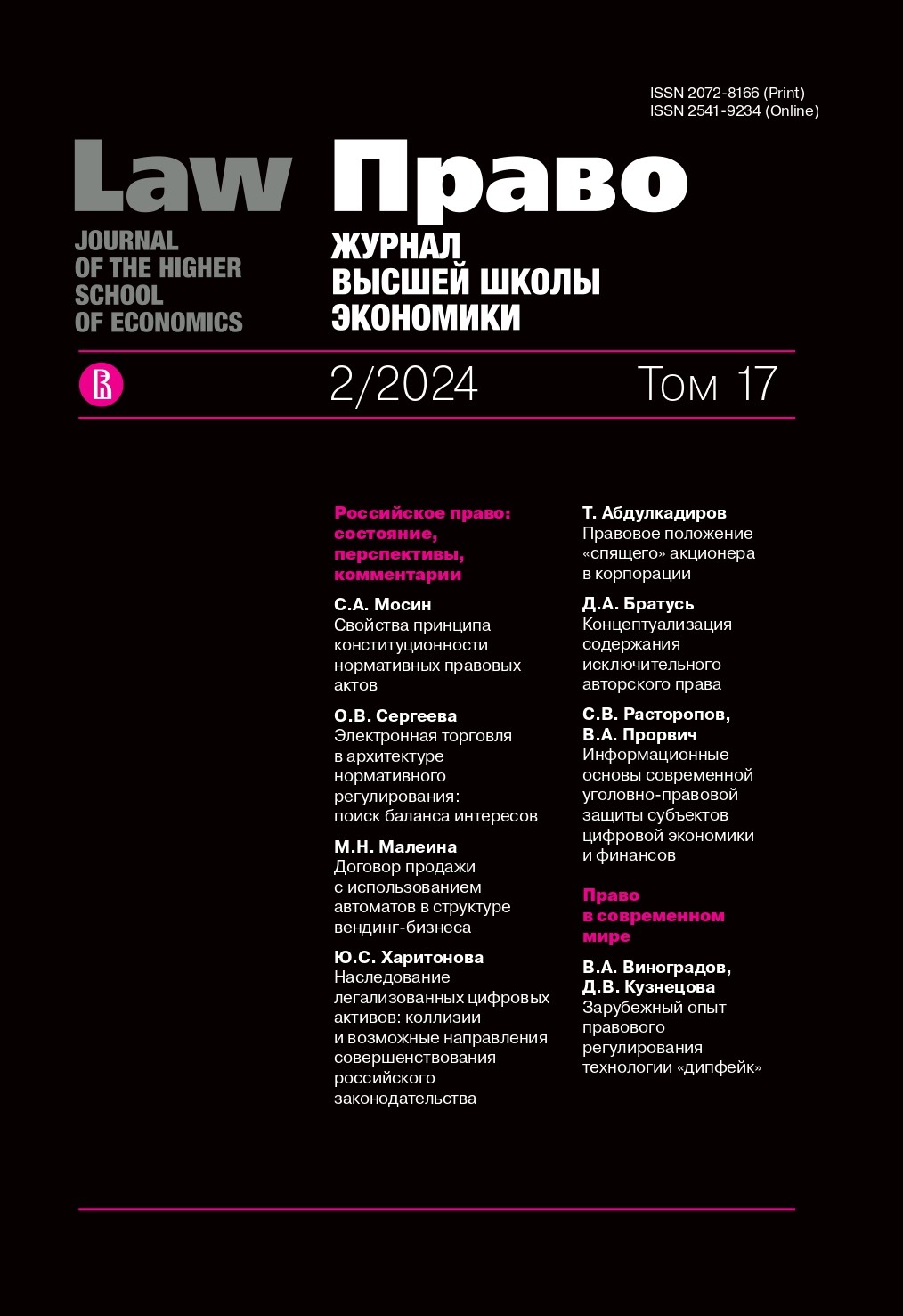Information Bases of Modern Criminal Law Protecting Subjects of Digital Economy and Finance
Abstract
The value of criminal law protecting digital economy and financial entities largely depends on the integrated application of tools created within the framework of the sciences of criminal law and information blocks. Computer modeling plays an important role in the proper criminalization of new social relations in the field of digital rights recently introduced into the current legislation, which are actively used by cybercrime of various types. The main sources of legal errors in the organization of criminal law protection of subjects of digital rights arise due to attempts to “mechanically” transfer some concepts from arithmetic, physics, microelectronics and other natural sciences to the field of criminal law. Moreover, the legislator linked the concepts of “digital rights” with the new legal concept of “rules of the information system”. At the same time, that rules are created by the “owners” of information systems, and there are no relevant legal regulations on their structure and content at the level of federal laws. At the same time, interconnected information systems have long been used in making exchange transactions with equity securities, and non-alignment of the rules of these systems often lead to legal errors in identifying relevant criminal events. To prevent them, new ways of proper implementation of the tools of the information block sciences in the field of criminal law sciences are proposed. One of the most effective is the identification of legal algorithms from certain sets of criminal and civil law norms, which make it possible to form a detailed criminal law characteristic of a specific cybercrime and identify the features of its composition for proper qualification. Other types of legal algorithms make it possible to identify the features of the subject matter and the limits of proof in a criminal case of cybercrimes of this type. Still others need to use the methodology for investigating such cybercrimes in a cyclical mode with feedback loops to identify each of the crimes committed in the aggregate and differentiate their elements. The formation of hierarchical systems of legal algorithms of various types and purposes makes it possible to create on their basis a number of problem-oriented computer programs that ensure the proper enforcement of interactive information systems for the processing of electronic documents and other information in the identification, disclosure and investigation of crimes in the field of digital economy and finance.
References
Abdulvaliev A.F. et al. (2021) Crimes using information technology: qualification and features of investigation. Tyumen: University Press, 376 p. (in Russ.)
Bychkov V.V. (2022) Conceptual, strategic and doctrinal basis of legislative counteraction in Russia to extremist criminals using information and telecommunication networks. Zhurnal chastnogo i publichnogo prava=Ius Publicum et Privatum, no. 1, pp. 166-173 (in Russ.) DOI: https://doi.org/10.46741/2713-2811.2022.16.1.017
Efimova L.G. (2020) Sources of legal regulation of public relations in cyberspace. LexRussica, no. 3, pp. 114-120 (in Russ.) DOI: https://doi.org/10.17803/1729-5920.2020.160.3.114-120
Gaukhman L.D. (2013) Qualification of crimes: law, theory, practice. Moscow: Yurinfor, 543 p. (in Russ.)
Golovko L.V. et al. (2016) The course of criminal procedure. Moscow: Statut, 657 p. (in Russ.)
Lapin V.O. (2022) Theoretical basics of investigation in the field of entrepreneurial activity. Moscow: Yurlitinform, 360 p. (in Russ.)
Luzgin I.M. (1981) Modeling investigation of crimes. Moscow: Juridicheskaya literatura, 152 p. (in Russ.)
Maksimov S.V. et al. (2018) Digital criminology as a tool for combating organized crime. Rossiyskiy kriminologicheskiy zhurnal=Russian Journal of Criminology, no. 4, pp. 476-483 (in Russ.) DOI: https://doi.org/10.17150/2500-4255.2018.12(4).476-484
Opalsky A.P. et al. (2022) Lessons from the combating market manipulation: a manual. Moscow: Alpen-Print, 100 p. (in Russ.)
Romanovsky M.Yu., Romanovsky Yu.M. (2020) Mathematical principles of economophysics: a manual. Moscow: Institute of Computer Research, 360 p. (in Russ.)
Savenko N.E. (2023) Legaltech in the digital economy and legal regulation of economic activity of citizens. Pravo. Zhurnal Vysshey shkoly ekonomiki=Law. Journal of the Higher School of Economics, vol. 16, no. 1, pp. 145-171 (in Russ.) DOI: https://doi.org/10.17323/2072-8166.2023.1.145.171
Shmonin A.V. (2017) Trends in forensic decision-making algorithms in criminal proceedings.Trudy akademii upravlenia MVD=Works of the Academy of Management of Internal Ministry, no. 4, pp. 73-77 (in Russ.)
Talalina E.V. (2022) Data processing using artificial intelligence and the risks of discrimination. Pravo. Zhurnal Vysshey shkoly ekonomiki=Law. Journal of the Higher School of Economics, vol. 15, no. 1, pp. 4-27 (in Russ.)
Timoshenko A.A., Feyzov V.R., Chernov I.V. (2023) Scenario approach to the study of regulation in the field of cryptocurrencies in Russia. Rossiyskiy zhurnal pravovykh issledovaniy=Russian Journal of Legal Studies, no. 2, pp. 21-30 (in Russ.)
Yankovsky R.M. (2020) Cryptocurrencies in Russian Law: Surrogates, “other property” and digital money. Pravo. Journal Vysshey shkoly ekonomiki=Law. Journal of the Higher School of Economics, vol. 14, no. 4, pp. 43-77 (in Russ.) DOI: https://doi.org/10.17323/2072-8166.2020.4.43.77
Zhdanov Yu.N., Ovchinsky V.S. (2020) Cyberpolice of the 21th century: international experience. Moscow: Mezhdunarodnye otnoshenia, 288 p. (in Russ.)





